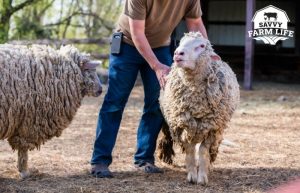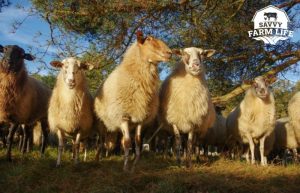
Ways to Catch a Sheep You Should Know
Sheep can be timid animals, some preferring to avoid human contact as much as possible. But while they are content to remain out in the pasture with the company of only their flock members, there will come a time when you will need to catch one or more of your sheep.
What is the best way to catch a sheep? The best way to catch a sheep will depend on your flock size. If you have a larger operation, you will likely have invested in a well-trained herding dog or sheep handling equipment, such as a chute and catching pen. If you have a smaller flock, however, you will be able to catch a sheep using a leg crook, neck crook, or by simply by getting ahold of the animal’s head and keeping it from going forward. Read on to learn more about how to catch a sheep without the use of large-scale equipment.
The good news is that if your sheep have been handled regularly since birth by humans, they should be much easier to catch than most sheep. Sheep are naturally flight animals and will want to flee from any chaos or activity that may arise. In this article, I’ll walk you through different ways you can catch your sheep or ways you can help them feel more comfortable with being caught.
How To Catch A Sheep
Assuming you do not have a large operation with chutes and gathering pens, you will want to use the sheep’s natural flocking instinct to your advantage. Begin by moving the sheep toward their flock. You can use your spouse, your neighbor, or your kids to help you with this – simply span out and walk toward the sheep until they move in the direction you want them to go. When attempting to catch an individual sheep, try to push the sheep into the flock. If the sheep moves into the flock (especially a large flock), she will get stuck and will be unable to flee from you. Now that you have your sheep confined within the flock, how do you grab her?
Shepherd Crooks
You have likely seen shepherd crooks – these can be either neck crooks or leg crooks. To use a neck crook, you will catch the curved end around the sheep’s neck and twist your wrist so that he does not pull back out of the crook. If you are using a leg crook, you will want to crook the leg above the shank joint. Once you have hold of the leg, gently pull upward instead of back – this will limit the control that the sheep has.
When approaching and herding your sheep, you will want to remain calm and unthreatening. Hold the shepherd’s crook in a neutral, un-intimidating position and walk along the side of the chosen sheep if possible.
Holding The Sheep’s Head
 If you do not have a crook to use, do not fret. Though this does require you to get up close and personal with your sheep, if you are able to grasp the head of the sheep correctly, you will be able to control them. To use this method, cup your hand under the sheep’s jaw as you move toward them. Once close enough, grab hold of the sheep’s jaw and gently but firmly lift the sheep’s head upward. If a sheep’s head is pointing up, this significantly limits the amount of power and control they have. If the sheep’s head is down, it allows them more power and movement.
If you do not have a crook to use, do not fret. Though this does require you to get up close and personal with your sheep, if you are able to grasp the head of the sheep correctly, you will be able to control them. To use this method, cup your hand under the sheep’s jaw as you move toward them. Once close enough, grab hold of the sheep’s jaw and gently but firmly lift the sheep’s head upward. If a sheep’s head is pointing up, this significantly limits the amount of power and control they have. If the sheep’s head is down, it allows them more power and movement.
Sheep rely on their flock for protection and security. To learn other ways sheep may protect themselves, visit my article How Do Sheep Protect Themselves? Essential Guide.
Things You Should Know Before Trying to Catch a Sheep
In order to successfully catch a sheep, it is important to understand sheep behavior. Sheep are prey animals, and do not like being chased. They are also flock animals, and will find safety in numbers. It is important to keep this in mind, in addition to the sheep’s flight zone and point-of-balance.
Know Your Sheep’s Flight Zone
You will want to know your sheep’s flight zone, and this zone will vary according to the individual sheep. The flight zone is the radius space around the sheep where the sheep goes from feeling safe and unthreatened to anxious and endangered. While approaching your sheep, they will flee as soon as you enter their flight zone. Some sheep have a large flight zone – these are the more feral sheep. Some pet sheep may have no flight zone at all. It is important to know your sheep’s flight zone so that you know what you are working with.
Understand a Sheep’s Point-Of-Balance
A sheep’s point of balance is at the shoulder. This means that if you are behind the shoulder, the sheep will instinctively move forward. If you are in front of the shoulder, the sheep will move backward. This is helpful to keep in mind as you are trying to “herd” the sheep – if you want the sheep to move forward, make sure you are behind the point-of-balance, or behind the shoulder.
Take Advantage Of Your Sheep’s Routine
If your sheep are grain or hay-fed, you may want to catch your sheep at feeding time. If your sheep come into the barn in the evening, you may want to catch your sheep when they come into the barn. It is helpful to take advantage of these routines when trying to catch your sheep. Not only will it be easier to catch them when they are trained to come to a specific location on a regular basis, but taking advantage of this routine will help to keep them calm and (relatively) relaxed.
Limiting Stress While Catching Your Sheep
Sheep are especially sensitive to stress. To limit harm, both physically and psychologically, it is important to make the catching process as smooth as possible. If you have young sheep, it will provide you with great benefit to train them from an early age so that they are trusting and have positive associations with you. If your sheep are not particularly fond of human interaction, make sure to remain as calm as possible. Do not run to chase them. Do not yell. Do not rush them. Speak calmly and firmly, and walk with confidence and composure. Reducing stress as much as possible will not only make it easier to catch the sheep in the short-term, it will benefit your relationship with your sheep in the long-term.
Put Your Sheep in a Smaller Area to Be Caught
If you’re trying to catch your sheep out in a big open field, it can be difficult since the sheep will have many places to escape to. By putting your flock in a smaller pen, it limits the area your sheep can run to. It will be much easier to catch them and won’t create as much chaos as chasing a sheep across a field.
Why You Might Want To Catch Your Sheep
There are many reasons you might want to catch an individual sheep or two. Sheep require regular maintenance, including hoof trimming, annual shearing, vaccinations, and de-worming. For these reasons alone, it is important to get your animals used to being handled. You may also want to catch a sheep if you notice any signs of an injury or illness that needs further investigation.
Should You Use A Herding Dog To Catch Your Sheep?
While we discuss the process of herding and catching sheep, you may find yourself wondering about the use of herding dogs. Herding dogs are bred for this specific purpose, and there are a few dog breeds that are used for herding sheep specifically. If you have a well-trained herding dog, you may find this an invaluable solution to catching sheep.
However, herding dogs require a significant up-front time investment. When bringing a puppy or untrained dog home, you will have to put a lot of time into training the dog to herd your flock appropriately. While the act of herding is in some breeds’ DNA, it will require significant training to hone this instinct and turn it into a valuable tool. An untrained dog can cause more stress and harm to your sheep and make your job even harder.
The most popular sheep herding dog breed in the US is the Border Collie. Other popular sheep herding breeds include the Australian Shepherd, the Rough- (or Smooth-) coated Collie, and the Bearded Collie. Each breed has its own advantages and innate way of working with livestock. If you decide to purchase a puppy for herding purposes, make sure you purchase the puppy from working parents, and not necessarily from show parents.
Frequently Handled Sheep Are Easier To Catch
It should go without saying that the more feral your sheep, the harder they will be to catch. It is easier to start with lambs – training them not to fear humans by providing a lot of gentle handling from as young an age as possible. Sheep raised in this way are much easier to handle as adults, and you may find yourself not needing any of the sheep catching techniques outlined in this article.
One word of caution – just as a sheep with positive interactions with humans will be more trusting, a sheep who has had negative interactions with humans will be more wary of them. Sheep have long memories, and will remember being treated poorly for years – if you are impatient and rough with your sheep, they will hold onto that memory and will be more difficult to handle.
Long-term memory is just one of the aspects that make sheep smarter than you think. To learn more about the intelligence of sheep, visit my article How Smart Are Sheep? (The Answer Will Surprise You.)
Halter-Broken Sheep
If you are starting young, it may benefit you to work on halter-breaking your lambs. If a sheep is halter-broken, it makes catching and handling much easier. Attempting to halter an untrained sheep, however, will be fruitless.
Which Method Will Work For You?
There are many different methods that you can choose from when catching and handling sheep – from crooks, to equipment, to herding dogs. Which method you choose will depend on the size of your flock and how much time and money you would like to invest. Fortunately, for the small flock owners, not much is required to catch a sheep aside from patience and an extra set of hands.
Understanding sheep behavior can help you know how to better handle your flock. To learn more about sheep behavior, check out my article Sheep Behavior: Ultimate Sheep Behavior Guide.
